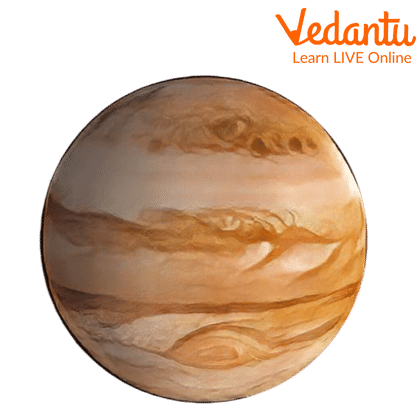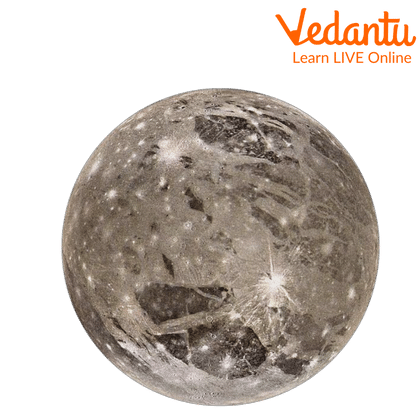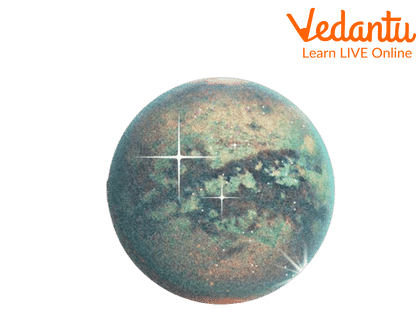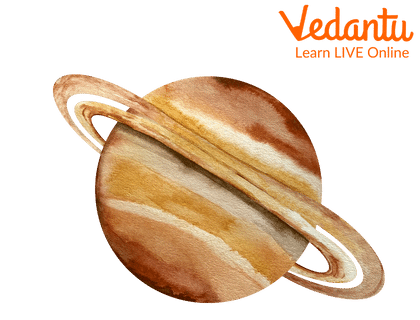




Facts About Titan (Saturn's Moon)
There are more than 200 moons in our solar system, of which the largest moon is Ganymede (Jupiter's Moon), and it revolves around the planet Jupiter. After this comes a moon of the planet Saturn, whose name is Titan. It is the second largest moon in the solar system and it is also very special for us humans because it is the only moon that has a very dense and exactly like a planet's atmosphere.

Jupiter.

Ganymede Moon
Titan’s Atmosphere
Titan's atmosphere, composed of 95% nitrogen gas and 5% methane gas, is the strongest in the solar system; in addition to these two gases, it also contains the organic molecules carbon and hydrogen necessary for life.

The Titan.
Titan's Size and Saturn's Orbit
Talking about the size, the diameter of Titan is about 5150 km, almost equal to Mars. Its surface temperature is -179 °C, which makes water as strong as stone and liquid like methane. Its surface pressure is slightly higher than the surface pressure of our Earth.
If we talk about its orbital period, then Titan completes one revolution of Saturn in equal time to 16 days of Earth. Due to being closer than its planet, it looked like our moon, which means that the surface of one side of Titan always remains in front of Saturn and the other away from it.

The Saturn.
Titan Craters
Scientists previously believed that the hydrocarbon (a compound consisting entirely of hydrogen and carbon). Lakes present on Titan were formed due to the melting of solid things present there. But, according to new research published in Nature GeoScience, the craters present on Titan are the result of explosions of nitrogen gas.
In fact, due to the increase in the surface temperature of Titan, nitrogen gas turns into steam and comes out with a bang, which creates large craters. Later these pits are filled due to rain of methane, ethane and hydrocarbons, and this is how hydrocarbon lakes are formed on Titan.
Solved Questions
1. Why is life expected to be found on Titan?
Ans: We only know about the earth with the belief that there is life here, so where else there can be life, we do not know. However, we do know that life is made up of complex organic molecules (a complex molecule that contains the element carbon bonded with other elements). This is something that we find on Titan in substantial quantities, in the form of the complex chemical 'Tholin' that we don't know much about. Tholin may be more like tar to life than we know it, but it may be an organic molecule necessary for the beginning of life.
2. How different is it to design missions and equipment for Titan or Saturn than for Mars or the Moon?
Ans: Titan is very different from the Moon or Mars because its atmosphere is much thicker, and denser than Earth's. It is also extremely cold, with an average temperature of -180 °C. This means that everything we design must be able to operate far below the temperature of Earth or Mars (such as the midnight temperature on the Moon).
Practice Questions
Write True or False.
There are only 200 Moons in our Solar System.
The name of the largest Moon is Ganymede.
In 2003, the Cassini spacecraft was sent to collect more information about Titan.
Titan is many times better than Mars in terms of settling down.
Summary
Titan is the second largest moon of the planet Saturn in the Solar System. Titan's atmosphere is composed of 95% nitrogen gas and 5% methane gas. It also contains the organic molecules carbon and hydrogen necessary for life. The diameter of Titan is about 5150 km, which is almost exactly equal to Mars. The craters present on Titan are the result of explosions of nitrogen gas.
FAQs on The Titan (Moon) Facts
1. What is so special about Saturn's moon, Titan?
Titan is unique among all the moons in our solar system because it is the only one with a dense, Earth-like atmosphere. It also has stable bodies of surface liquid, including rivers, lakes, and seas. However, these are composed of liquid methane and ethane, not water.
2. How big is Titan compared to Earth's Moon?
Titan is significantly larger than Earth's Moon. With a diameter of about 5,150 kilometres, it is the second-largest moon in the solar system. It is even larger than the planet Mercury.
3. What is the surface of Titan like?
Titan's surface is a fascinating and diverse landscape shaped by processes similar to those on Earth. It features:
- Vast plains and dunes made of dark, sand-like hydrocarbon particles.
- Cryovolcanoes that may spew a mixture of water and ammonia.
- A solid surface crust made mostly of water ice, which is as hard as rock at Titan's frigid temperatures.
- Lakes and seas of liquid methane and ethane, primarily located near its polar regions.
4. What is the temperature on Titan?
Titan is extremely cold because it is so far from the Sun. The average surface temperature is about -179 degrees Celsius (-290 degrees Fahrenheit). At this temperature, water is frozen solid and behaves like rock.
5. Does Titan have water or oxygen?
Titan's atmosphere is about 95% nitrogen and 5% methane, with almost no free oxygen to breathe. While there is a huge amount of water on Titan, it exists as solid ice, forming much of the moon's crust and surface features. Liquid water may exist in a subsurface ocean deep beneath the icy shell.
6. Why do scientists believe Titan might resemble an early version of Earth?
Scientists are interested in Titan because it provides a model of what a very young Earth might have been like. Its nitrogen-rich atmosphere is similar to Earth's early atmosphere, and it has complex organic chemical processes occurring. Studying Titan helps scientists understand the potential pathways for the origin of life, even though its extreme cold prevents life as we know it from developing on the surface.
7. Could humans ever live on Titan?
Living on Titan would be extremely challenging and impossible without advanced technology. The main obstacles are the extreme cold, the lack of breathable oxygen, and an atmospheric pressure slightly higher than Earth's. Humans would need completely sealed, heated habitats with a constant supply of oxygen. The liquid methane on the surface would also be a significant hazard.
8. Is Titan the largest moon in our solar system?
No, Titan is the second-largest moon in the solar system. The largest moon is Jupiter's moon, Ganymede. While Ganymede is slightly larger in diameter, Titan is often considered more complex due to its thick atmosphere and active weather systems, which Ganymede lacks.
9. Why is it so difficult for spacecraft to explore Titan?
Exploring Titan presents several major challenges:
- Great Distance: Titan is about 1.4 billion kilometres from the Sun, making missions long and expensive.
- Thick Haze: Its thick, orange smog-like atmosphere makes it impossible to see the surface clearly in visible light, requiring radar or infrared instruments.
- Extreme Cold: Any lander or rover must be heavily insulated and heated to operate in the -179°C temperatures.
- Complex Landing: The thick atmosphere requires a robust heat shield and parachute system for any craft attempting to land on the surface.









